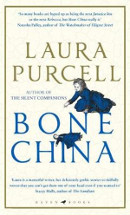Bone china by Laura Purcell

Bloomsbury, 2019. ISBN: 9781526602527. 384pp.
(Age: Adolescent - Adult) This story begins with Hester Why's
enigmatic statement that 'love is fragile' and it is indeed clearly
her past experiences, her fear and unsettled present that, we
gather, are 'dragging her' to Cornwall in the midst of a chilling
winter, to find work as an escape from her previous life. Doctor
Pinecroft's large house, in which she is to live and work, is
depicted as 'grey, wide and squat' standing with its 'rough-cast
face' on the 'crest of the cliff'. This gripping tale tells of the
harshness of life at that time, as we are drawn into the chill, and
indeed the dread that Hester experiences daily, knowing that not
only might she catch the disease, but also is aware that her
employers would fire her if they were to discover her past and her
secrets.
Doctor Pinecroft is described as a visionary, determined to find a
way to treat the tuberculosis that has heavily affected his family,
and indeed that has taken the lives of so many others, but is also
in search of a cure. In his bold experiment, a group of prisoners
from a local gaol in Cornwall are released into his care. He sets up
a campsite, where he daily spends some time with them living in old
caves by the sea. His wild plan is that the crippling cold and sea
air will enable the men to beat the disease - a desperate hope.
Working for the doctor's family, Hester is one of the few women
involved in supporting the men. As the story is told through her
experiences, we learn about the lives of the servants of that era,
and their ever-present fear of illness and poverty. Opium, alcohol
and other drugs appear to be available, and we read of the problems
that these and other drugs cause. Yet we are positioned to grasp the
dread of the illness experienced by so many people during that time,
and to understand the consequent despair that runs through the whole
narrative. It is a wild story in its own way, lively, evocative and
sadly indicative of the terrible living conditions for many people
in that historical time and place.
This intriguing narrative, that gives us a vivid picture of the way
people lived and of the understandable fears that troubled everyone
at that time, is a comprehensive, well-written work that would be
most suitable for both adult and adolescent reading.
Elizabeth Bondar